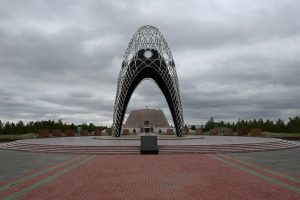It’s as if Ashgabat and Dubai had a love child, placed it in the Dakotas – and changed all the signs to Cyrillic. I’d flown in from Almaty the day before, leaving Kazakhstan’s biggest city behind to spend a few days in the country’s new capital.
The seat of government was moved there in 1997, officially because the mountains around Almaty restricted further expansion, not to mention the region’s seismic activity. Speak to any Kazakh expert, however, and they say that the actual reason was to try and keep the country together by locating the capital closer to the restless north This is an area where most people are ethnic Russians.
Given that the city holds the world record for the capital city with the most name changes – Akmoly has transformed into Akmolinsk, Tselinograd, Akmola, Astana, Nur-Sultan, and now Astana (again) – you’d be forgiven for thinking that much of the city’s history has been forgotten, such is the pace of change in the “Space Station of the Steepe.”
However, once you’ve spent a couple of days exhausting all of Astana’s tourist attractions – the lollipop stick tower designed by the president (closed when I was there), the biggest mosque in Central Asia and a tent-shaped shopping mall with a beach from the Maldives – you might be wondering for thinking what else to do.
This is how I ended up taking a trip to one of the most barren, notorious gulags in the whole of Central Asia.
What was the Alzhir Gulag?
Firstly, for those wondering what Alzhir means or who think that it doesn’t sound very “Central Asian,” it’s actually an acronym. The gulag’s full name translates into English as the “Akmola Camp for the Wives of Traitors to the Motherland.”
Those imprisoned in Alzhir jokingly called it “Algiers,” the similarly-named capital of Algeria. Like the Algerian Sahara, they said, the camp was both in the middle of nowhere and a place that few made it out of alive. Clearly, the stereotype about Russian dark humour holds up here.
The name also isn’t a euphemism, and all of those held in Alzhir were there simply for being married to someone that was seen as a “traitor to the motherland.” In Stalin’s USSR, the definition of who was considered a “traitor” was vague to the point of meaningless.

In practical terms, this meant that if your husband had one too many vodkas and made an ill-informed “joke” about the Soviet leadership (defined very broadly) or if you fell out with your neighbour and they made up rumours about you to the KGB, you could also find yourself at Alzhir or one of its hundreds of contemporaries across the Soviet Union.
What is it like to visit?
For context, I visited in late May, and despite the weather having been balmy back in Almaty, a crisp frost covered much of the barren prairie. Nothing – neither the weather nor the camp – gave off any sense of warmth. In other words, bring something cozy to wear, whenever you go.
Some people who go to Alzhir complain of being underwhelmed, and of expecting a labour camp that is preserved as it would have been in the 1930s and 40s. Partly due to being made of wood – but also given the Soviet’s wanting to cover up their crimes – very little of the original gulag buildings remain today.
Despite this, there is an excellent museum, complete with both indoor and outdoor reconstructions of every part of the gulag. All the exhibitions are in Russian, with most also in Kazakh and English.

Inside, the museum is split onto two floors, with the bottom one dedicated to the history of Kazakhstan, the Gulag system, and the personal belongings and stories of the inmates. On the upper level, there are recreations of the camp’s interrogation rooms and living quarters, as well as accounts of the women’s lives once they left Alzhir.
Outside of the building, there is an open-air museum that features a replica train wagon, and is based on the ones use to bring the women to the gulag. People were sent here from dozens of countries – in the walk up to the museum there are stone plaques from many of these states, honouring their citizens.
Despite the appearance of several quotes from former President Nazarbayev (which, interestingly, have not been removed), the museum’s history seems pretty objective and accurate, albeit with the occasional insertion of Kazakh nationalism.
How do I get there?
Your two options are to hire a private taxi or to take public transportation. While you can (fairly easily) rent a car in Astana and drive there yourself, this is not worth doing unless you are already planning a road trip to other parts of Kazakhstan.
Buses 305 or 312 leave from the main bus stand every hour at half-past. This is next to Astana’s Asia Park shopping mall. For the princely cost of 200 Tenge (around $0.40), you are driven 45 minutes out of the city – just far enough for the skyline of Astana to disappear. The locals on the bus were very friendly, so expect to be asked questions and practice some Russian!
If you want to travel in more comfort, most taxis will take you there, wait while you visit, and return you to Astana for around 20,000 Tenge, or around $40. This saves a lot of the stress of co-ordinating buses, expecially if your Russian, Kazakh, or Cyrillic reading skills do not exist. The ubiquitous Yandex app technically will offer to take you out this far, but good luck getting a driver to accept such a ride.
Get off the bus once you’re in the town of Akmol, and from there, it is easy to find Alzhir. Its entrance is marked by a giant silver monument, which looks like a conical but is instead a giant representation of a Kazakh bridal headdress. This is especially poignant when you consider that over 1,500 children were born in the camp, as a result of inmates being raped by their guards.

The entrance fee to the museum is 1,200 Tenge (around $2.40), and expect to spend at least an hour walking around and taking everything in. Akmol isn’t exactly the party capital of Central Asia, so bring snacks with you. The bus back to Astana leaves from where you were dropped off, but the exact times seem a bit all over the place.
All being said, Alzhir is an excellent day trip from Astana, allowing you to remove yourself from the capital’s excesses and learn about Kazakhstan’s brutal yet important history. We offer regular trips to the country – including many that start and end in Astana – so get in touch if you would like to add this to your itinerary.





